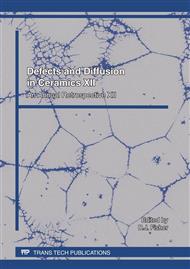[1]
C.B. Fitzgerald, M. Venkatesan, J.G. Lunney, L.S. Dorneles, J.M.D. Coey: Applied Surface Science, 247 (2005) 493.
DOI: 10.1016/j.apsusc.2005.01.043
Google Scholar
[2]
T.P.J. Han, M. Villegas, M. Peiteado, A.C. Caballero, F. Rodríguez, F. Jaque: Chemical Physics Letters, 488 (2010) 173.
DOI: 10.1016/j.cplett.2010.02.028
Google Scholar
[3]
Z.L. Lu, X.F. Bian, W.Q. Zou, M.X. Xu, F.M. Zhang: Journal of Alloys and Compounds, 492 (2010) 31.
Google Scholar
[4]
S. Ghoshal, P.S.A. Kumar: Journal of Magnetism and Magnetic Materials, 320 (2008) L93.
Google Scholar
[5]
X.Y. Zhou, S.H. Ge, D.S. Yao, Y.L. Zuo, Y.H. Xiao: Physica B, 403 (2008) 3336.
Google Scholar
[6]
J.H. Yang, Y. Cheng, Y. Liu, X. Ding, Y.X. Wang, Y.J. Zhang, H.L. Liu: Solid State Communications, 149 (2009) 1164.
Google Scholar
[7]
A.S. Chakravarty: Introduction to the Magnetic Properties of Solids (Wiley Interscience Publications, New York, 1980).
Google Scholar
[8]
A. Abragam, B. Bleaney: Electron Paramagnetic Resonance of Transition Ions (Oxford University Press, London, 1970).
Google Scholar
[9]
R.M. Macfarlane: Physical Review B, 1 (1970) 989.
Google Scholar
[10]
Y.Q. Jiang, N.C. Giles, L.E. Halliburton: Journal of Applied Physics, 101 (2007) 093706.
Google Scholar
[11]
A. Hausmann: Physica Status Solidi, 31 (1969) K131.
Google Scholar
[12]
E.H. Kisi, M.M. Elcombe: Acta Crystallographica. C, 45 (1989) 1867.
Google Scholar
[13]
L.H. Wei, S.Y. Wu, Z.H. Zhang, H. Wang, X.F. Wang: Modern Physics Letters B, 22 (2008) 173.
Google Scholar
[14]
M.L. Du, C. Rudowicz: Physical Review B, 46 (1992) 8974.
Google Scholar
[15]
D.J. Newman, B. Ng: Reports on Progress in Physics, 52 (1989) 699.
Google Scholar
[16]
W.L. Yu, X.M. Zhang, L.X. Yang, B.Q. Zen: Physical Review B, 50 (1994) 6756.
Google Scholar
[17]
D.J. Newman, D.C. Pryce, W.A. Runciman: American Mineralogist, 63 (1978) 1278.
Google Scholar
[18]
Z.Y. Yang: Journal of Physics - Condensed Matter, 12 (2000) 4091.
Google Scholar
[19]
P. Koidl: Physical Review B, 15 (1977) 2493.
Google Scholar
[20]
E. Clementi, D.L. Raimondi: Journal of Chemical Physics, 38 (1963) 2686.
Google Scholar
[21]
E. Clementi, D.L. Raimondi, W.P. Reinhardt: Journal of Chemical Physics, 47 (1967) 1300.
Google Scholar
[22]
J.S. Griffith: The Theory of Transition-Metal Ions (Cambriddge University Press, London, 1964).
Google Scholar
[23]
B.R. McGarvey: Journal of Chemical Physics, 71 (1967) 51.
Google Scholar
[24]
E.K. Hodgson, I. Fridovich: Biochemical and Biophysical Research Communications, 54 (1973) 270.
Google Scholar
[25]
A.B.P. Lever: Inorganic Electronic Spectroscopy (Elsevier Science Publishers, Amsterdam, 1984).
Google Scholar
[26]
H.N. Dong, X.X. Wu, S.Y. Wu, W.C. Zheng: Acta Physica Sinica, 51 (2002) 616.
Google Scholar
[27]
A. Fazzio, M.J. Caldas, A. Zunger: Physical Review B, 30 (1984) 3430; 29 (1984) 5999.
Google Scholar
[28]
N. Gemma: Journal of Physics C, 17 (1984) 2333.
Google Scholar


